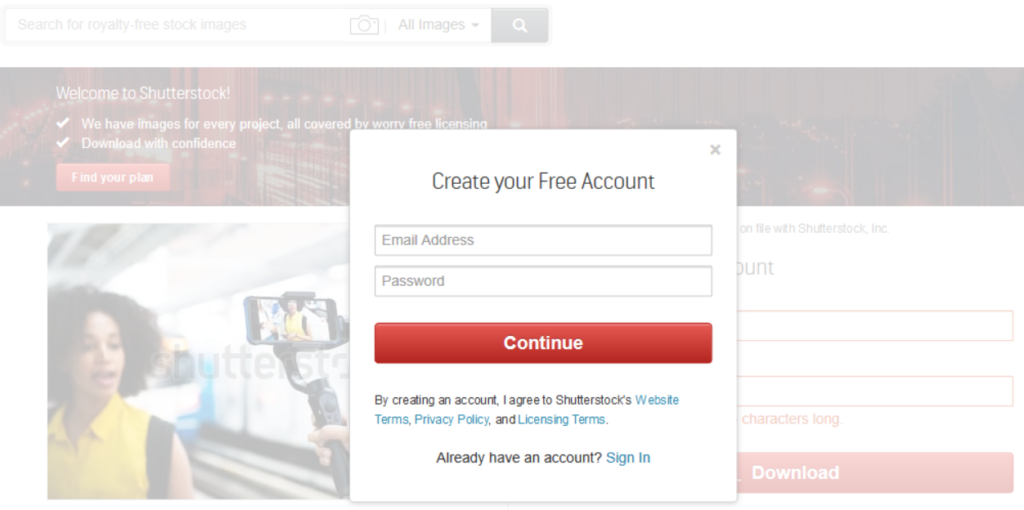Using content creation as an SEO strategy is a popular way of boosting your site’s search engine rankings. However, there’s no such thing as a free lunch and this applies to some of the content that you know and love. At SEO Sydney we call this content gating, or hiding some of the content on your site from users who haven’t yet given you anything in return.
The idea is not new, and is probably best known in this kind of circumstance:
In this example, The Washington Post has put its articles, videos and analyses behind a gate that asks for payment for a subscription. Newspapers use an extreme form of content gating – keeping certain content from users without them paying – as a way of sparking interest in certain articles for online readers before asking them to monetise the transaction by taking out a subscription. By allowing users to access a limited number of free articles, publications are able to build a relationship of trust so that you know the type of content that you will be paying for if you do choose to take out a subscription.
A less extreme and more common form of content gating involves asking users for information rather than money before they are able to receive certain content. Typically, this appears in the form of asking for your name and email, and in certain cases for more information like your phone number, company and salary range.
Shutterstock frequently engages in this kind of content gating as a way of distributing their stock photos. The user doesn’t have to pay money for the content (which is typically better quality than other free stock photos), but rather pays with information about themselves.
For some people, this elicits an uncomfortable feeling because they are used to the free range of the Internet. In reality, content creation by some sites is far more valuable and marketers require a trade – information given for some basic points about your identity. This may not faze users – your name and email address isn’t your credit card number, right? For others, the potential of a clogged inbox full of newsletters and advertising is too steep a price to pay for a single article that they want to read. More importantly, content gating can block any content creation SEO strategies that you’ve put in place.
Content gating doesn’t work well with SEO because search engine bots don’t have the information required to fill out a form. If you’ve spent time optimising this content with keywords and carefully placed headings, these SEO strategies will be a waste of time because search engines won’t index these pages. Furthermore, if you include content gates there is a greater probability that users will become frustrated and spend less time on your site, thereby increasing your bounce rate. A high bounce rate indicates to search engines that your site is less popular and will therefore slip down the rankings.
The advantages of content gating include what is considered treasure among business owners in terms of digital marketing– data. Even if you are not monetising the content of your site, any information that can be gleaned from your target audience is very valuable. Maintaining a database of emails and other information about your potential clients can indicate exactly who is visiting your site, meaning that you can tailor your content to them and reduce your bounce rate. For a digital marketing strategy, any small insight that can improve conversion rate is beneficial. Furthermore, this database allows you to easily create an email marketing campaign, or extend one that you already have. Plus, you know that the users who do readily hand over their information are high quality leads and are genuinely interested in finding out more. It is these visitors to your site that are most likely to convert to paying customers.
A type of content gating was a popular method of obtaining Facebook likes until the site put a stop to the process in 2014. Before the change in the platform, certain pages required users to ‘like’ it before they could listen to songs, watch videos, or enter competitions.
The practice was stopped because Facebook did not agree with the practice of artificial incentives for their pages.
There are other disadvantages to a content gating campaign too. Your site will lose navigation points because of the roadblocks that the gates present. Anything that is seen as an obstacle is likely to frustrate the user, particularly if the site is on a mobile device. What’s more, it might be perceived at cutting corners in the marketing process. There is no building of relationships involved with these leads, something that has again and again proved valuable to small business marketing. When potential consumers don’t know you and start to receive email campaigns from you, they could feel as if they are being ambushed and will develop negative perceptions of your brand.
If you’ve weighed up the pros of content gating against the most effect SEO strategy, and have decided to say a resounding yes to more in-depth content creation, there are certain aspects that you need to consider.
Know what stage of the process your business is at. If you’re just starting out in your business the aim of the game is to get your face, brand and content out to anybody who could possibly spend time looking at it. If you’re trying as hard as you can to broaden your audience, content gating is not the way to do it. A better option for younger businesses is to invest in basic SEO to make sure that more of your content can be seen by a greater number of potential clients on search engine results pages. Alternatively, if you’ve spent some time developing your web presence and the quality of your content, and your web traffic is already quite significant, you’re in a better position to start asking your readers for something in return.
Think about what you really need to collect. Know that the more you ask for, the greater the threat that customers will leave your site. The most significant thing to ask for is money in exchange for content, given that users have become accustomed to accessing most parts of the Internet for free. If you’re just asking for information most customers won’t see a name and email address as being too invasive, unless you start asking for more specific fields.
For example, the information asked for by HubSpot is specific – the site knows that its users are primarily involved in digital marketing, and that those who want to access these templates will have information to fill out the required fields. However, if it takes more time to fill in the necessary form more people are going to opt out of getting your content. Asking for too much information with a content gating strategy could have the opposite effect of what is intended for a digital marketing campaign.
Your gated content needs to be unique. If your content can equip the readers with something they can’t get anywhere else, then it users will be more willing to make a trade. A rule of thumb is that infographics and anything embedded in Youtube shouldn’t be gated, because they can so easily be shared with other social media sites.
Your gated content needs to be useful. Building upon the last point, there is so much content out there on the web that anything gated needs to be particularly meaningful for your users. Think about whether the content equips your users with a new skill or knowledge. If it doesn’t, it might be just be what is known as ‘millennial content’ – fast and simple quizzes, videos or surveys that are a dime a dozen on hundreds of other more established blogs out there. Keeping in mind that content creation should be dynamic, if you’ve put a significant amount of effort into one particular piece that could be useful to clients (and it’s more than approximately 6 pages in length) then content gating could be a suitable approach.
Consider relationship building through content gating. If you’re just starting out with creating more valuable content, consider making some articles or papers free of charge initially so that you can build loyalty to your site. Later, introduce a content gate by asking for the most basic information – such as name and email – and then, if you require more information for data purposes, build up to asking your readers for more detailed information about themselves. This process may take more time, but your readers will also be more inclined to trade their personal information if they already know that you produce worthwhile content.
For more SEO-related content, check out SEO Sydney – the #1 Location for Professional and Proven SEO services and resources




